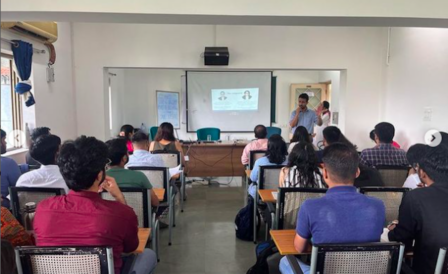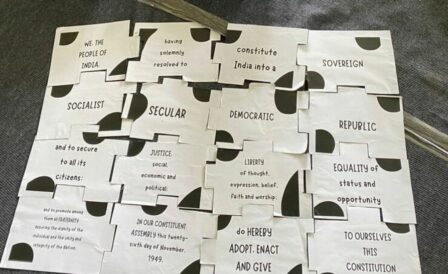On June 25th 2022, the ConsitutionofIndia.net team at CLPR conducted an ‘Indian Constitutional History’ workshop for students at the National School of Journalism and Public Discourse (NSoJ).

The workshop introduced students to the Indian Constitution and its history. It emphasised the relevance of primary materials like the Constituent Assembly Debates and the Historical Constitutions to journalists who report and write about contemporary India.
The Constituent Assembly Debates
The Session began with a video of the England v New Zealand cricket match from the 2019 World Cup, where a dispute arose, requiring the intervention of the umpire. CLPR resource person Vineeth Krishna drew parallels between an umpire who interprets the rule book to decide on an unforeseen dispute to a judge who relies on the Constitution to adjudicate a matter in the Court of law. He explained that a Constitution is akin to a rule book for India— it governs relations between the Legislature, Executive and the Judiciary. It also governs relations between the Centre and the States, the State and the citizen, and the relations between citizens.
The discussion then turned to India’s constitution-making process. Vineeth explained that the Constituent Assembly of India, that comprised around 300 members, meticulously deliberated and drafted the Constitution of India 1950, in 166 sittings between 1946 and 1950. A dramatic portrayal of these debates, in the Rajya Sabha documentary series titled ‘Samvidhan’ was screened to give students a sense of how the Assembly debated a provision of the Constitution. He told the students that all these debates were transcribed and that these could be accessed through sources like the ConstitutionofIndia.net website.
Historical Constitutions
Vineeth asked the students if there was a constitutional imagination before 1946, when the Constituent Assembly began deliberations. They answered that the Indian Constitution relied heavily on the United States and other jurisdictions—that there was little to no history showing a constitutional imagination in India before independence. Contrary to what the students believed, Vineeth pointed out that there was a vibrant constitutional imagination before 1946. He introduced students to documents such as the Constitution of India Bill 1895, Government of India Act 1919 and the Nehru Report 1928, pointing out that many key portions of the Constitution as we know it are inspired by these Historical Constitutions.

Worksheet: Freedom of Speech
Students used ConstitutionofIndia.net to solve a pedagogically designed worksheet on freedom of speech that required them to carefully read primary materials on the site. Through this exercise, students were able to discover and tease out the origins and historical debates around the Constitution’s free speech provisions. A discussion of the worksheet followed, where students shared what they found in these materials. They also weighed in on some of the vexing questions that our Constitution framers had to deal with that included: on what grounds should freedom of speech be restricted?

The workshop ended with Vineeth reviewing the day’s learnings and highlighting how a vibrant constitutional culture is critical to sustain and promote India’s constitutional democracy.


